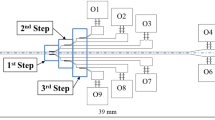Abstract
A novel analyzing method is presented, which allows precise characterization of cell-free layers (CFLs) of blood flowing through microchannels. The CFL occurs due to axial migration of the erythrocytes (RBCs). A confocal laser scanning microscope (CLSM) is used to detect the reflected light of channel walls and cells within the blood flow. Since the presented method does not depend on emitted fluorescence signals, there is no necessity for a complex sample preparation as fluorescence marking of cells. Furthermore, it allows the characterization of the thickness of the CFL in whole blood. Due to the high vertical resolution of the used CLSM, the developed characterization method enables measurements along the optical axis of the microscope. It is exemplarily used to analyze the thickness of the CFL in human blood flowing through microchannels as a function of the hematocrit and blood flow velocity. The microchannels are made of silicone rubber with a height of 100 µm. The microchannels are intended for a gas exchange application.













Similar content being viewed by others
References
Campbell NA, Reece JB (2002) Biology, 6th edn. Benjamin Cummings, San Francisco
Cerdeira T, Lima R, Oliveira M, Monteiro FC, Ishikawa T, Imai Y, Yamaguchi T (2009) Determination of the cell-free layer in circular PDMS microchannels. ECCOMAS Thematic Conference on Computational Vision and Medical Image Processing, Porto, Portugal
Fahraeus R, Lindqvist T (1931) The viscosity of the blood in narrow capillary tubes. Am J Physiol Leg Content 96(3):562–568. doi:10.1161/01.RES.22.1.28
Feng J, Hu HH, Joseph DD (1994) Direct simulation of initial value problems for the motion of solid bodies in a Newtonian fluid. Part 1. Sedimentation. J Fluid Mech 261(1):95. doi:10.1017/S0022112094000285
Garcia V, Dias RP, Lima R (2012) In vitro blood flow behaviour in microchannels with simple and complex geometries. In: Naik GR (ed) Applied biological engineering. Principles and practice. InTech, Rijeka, pp 393–416
Karnis A, Goldsmith HL, Mason SG (1966) The flow of suspensions through tubes: V. Inertial effects. Can J Chem Eng 44(4):181–193. doi:10.1002/cjce.5450440401
Lima R, Wada S, Tanaka S, Takeda M, Ishikawa T, Tsubota K, Imai Y, Yamaguchi T (2008) In vitro blood flow in a rectangular PDMS microchannel: experimental observations using a confocal micro-PIV system. Biomed Microdevices 10(2):153–167. doi:10.1007/s10544-007-9121-z
Lima R, Oliveira MS, Ishikawa T, Kaji H, Tanaka S, Nishizawa M, Yamaguchi T (2009) Axisymmetric polydimethysiloxane microchannels for in vitro hemodynamic studies. Biofabrication 1(3):35005. doi:10.1088/1758-5082/1/3/035005
Park CW, Shin SH, Kim GM, Jang JH, Gu YH (2006) A hemodynamic study on a marginal cell depletion layer of blood flow inside a microchannel. KEM 326–328:863–866. doi:10.4028/www.scientific.net/KEM.326-328.863
Rieper T, Wehrstein B, Maurer AN, Mueller C, Reinecke H (2012a) Evaluation model of an extracorporeal gas exchange device made of silicone rubber. Biomed Tech/Biomed Eng 57:1109–1112. doi:10.1515/bmt-2012-4191
Rieper T, Mueller C, Wehrstein B, Maurer AN, Reinecke H (2012a) Virtually monolithic device for diffusive mass transfer enabling high volume flow. In: Proceedings of The Sixteenth International Conference on Miniaturized Systems for Chemistry and Life Sciences (µTAS 2012)
Rieper T, Cvancara P, Gast, Sophie, Wehrstein, Bettina, Maurer, Andreas N., Mueller, Class, Reinecke, Holger (2013) An artificial lung based on gas exchange and blood flow optimization. In: Zengerle R (ed) Proceedings of the 17th International Conference on Miniaturized Systems for Chemistry and Life Sciences, pp 1188–1190
Segré G, Silberberg A (1962) Behaviour of macroscopic rigid spheres in Poiseuille flow. Part 2 Experimental results and interpretation. J Fluid Mech 14(01):136–157
Tilly de A, Sousa de JM, Willaime H, Pinto JF, Duate Silve OM, Bettencourt Moreira Silva I, Carrapico B, Semiao V (2010) Non-Newtonian micellar microflow visualization in a contraction Geometry. In: Proceedings of the 2nd European Conference on Microfluidics, μFlu’10, Toulouse, France, 08–10 December 2010
Acknowledgments
We thank the Life Imaging Center (LIC) of the University Freiburg, especially Dr. Roland Nitschke and Dr. Angela Naumann, for facilitating the measurements.
Author information
Authors and Affiliations
Corresponding author
Rights and permissions
About this article
Cite this article
Rieper, T., Čvančara, P., Müller, C. et al. Simplified analysis method of cell-free layers in blood flows as tool for the optimization of gas exchange devices. Microfluid Nanofluid 17, 1071–1078 (2014). https://doi.org/10.1007/s10404-014-1389-8
Received:
Accepted:
Published:
Issue Date:
DOI: https://doi.org/10.1007/s10404-014-1389-8




